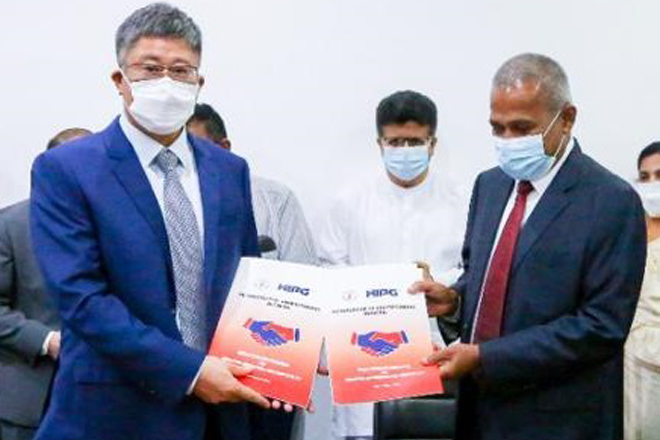The Ceylon Petroleum Corporation (CPC) signed a Memorandum of Understanding with the Hambantota International Port Group (HIPG), last week to develop Hambantota Port as a strategic energy center in Sri Lanka. The signing ceremony was held at the Ministry of Energy, with top officials of CPC and HIPG participating.
A separate storage terminal with associated facilities for both domestic and export purposes connected to the Port via a pipeline is to be established by CPC, about 15 Kilometers away from the Port. CPC, the state entity which provides the majority of petroleum products to local consumers, has identified a land area of approximately 50 Acres owned by Sri Lanka Mahaweli Authority for the project. The new facility is expected to expand storage and bulk distribution facilities of CPC.
The existing storage facility of CPC/CPSTL is sufficient to store refined petroleum product requirements of the entire country for a period of only one month, a capacity below the requirements of ensuring the energy security of the country. CPC currently imports refined petroleum products to cater to, approximately, 70% of the country’s demand via the Colombo port and suburbs. CPC has identified the need to increase its fuel storage capacity to cater to at least three months of the country’s demand.
“The growing demand for fuel in the past, combined with the country’s anticipated development in every aspect, has resulted in the opening up of opportunities for investors to establish ventures in Sri Lanka. In this context, CPC’s product portfolio has to be managed to suit the energy mix of the country if we are to be competitive, especially in comparison with other energy sources.
The partnership with HIPG will increase the storage facility of CPC to the expected capacity; thereby the impact of global fuel price fluctuations can be mitigated and it will drive CPC to minimize and save additional foreign currency outflows. Apart from that, setting up in the Hambantota Industrial Zone, away from the traffic congestion of the country’s most residential cities, will make it an environmentally-friendly terminal. Taking all these factors into account, I believe this partnership will put an end to the negative external factors of the country’s fuel market,” says Sumith Wijesinghe, Chairman of CPC.
HIPG will sublease the required land area within the Port, for the construction and operation of the pipeline, with approval of the Sri Lanka Ports Authority. All port and terminal related facilities and services, will be provided by the port including stevedoring services for the import, export and transshipment of petroleum products and crude oil subject to feasibility studies.
“The vision of HIPG is to develop the Hambantota International Port to become an energy hub for South Asia. Whilst HIPG has put the infrastructure in place to realize that goal, we are also aware that we cannot achieve it without the participation of all the players in the equation. To this end, we recognize the importance of Ceylon Petroleum Corporation as a vital cog in the machinery. The Hambantota Port is encouraged by this move by the corporation and as much as it will support the smooth and efficient supply of fuel to the customer it will also strengthen the position of this Sri Lankan port on the global maritime map,” says Johnson Liu, CEO of HIPG.
Tissa Wickramasinghe, COO of HIPG says the port has already launched the wholesale supply of Marine Bunker fuels. “In order to build this energy hub, we entered into a strategic partnership with Sinopec Fuel Oil Lanka Limited (SFOL) to provide bunkering services for vessels. Sinopec with their vast resources guarantees the supply of VLSFO and MGO in Hambantota, enabling the port to service all vessels plying the principal sea routes in the Indian Ocean. Transshipment of LPG and delivery for local consumption is also a part of the energy hub mix at HIP, and we have the two main players operating supply facilities within the port. We have also partnered with Intertek Lanka (Pvt) Ltd to establish a state-of-the-art petroleum testing laboratory, within the port to provide services to the energy hub, further strengthening HIP capacity to provide these services. Our goal is to ensure that all our stakeholders take maximum advantage of the port’s unique location. HIP has been operational throughout the pandemic and has followed all the necessary protocol under guidelines set by CMPort to ensure the health and safety of all involved,” he says.

